Outside time is critical for mental and physical health — especially for kids and families. Here are some ideas for activities that kids can do as a break from screentime.
updated 3/10/21
> BACK TO TOP
Year-Round Activities
Sit Spot
Pick a spot in your backyard or nearby to sit everyday. Twenty minutes or more is ideal, but even ten minutes is a good start for kids. Don’t have a yard? Do it on the front steps or balcony… anything that gets you outside for a few minutes of quiet. Not only is it good for the spirit, but it is a great chance to begin noticing the natural world around us.

A quiet spot to journal. (photo © Janet Altobello)
Just sitting is fine, but here are some other ideas for things to do during a sit spot:
- Make a sound map. Use a piece of paper or journal and mark your spot with an x. Create a symbol for each sound that you hear around you, and create a map of those sounds.
- Do a bird sit. This is similar to a sound map, but instead focused on birds. It’s okay if you don’t know the types of birds you’re hearing or seeing. This is an opportunity to really start noticing what the birds are doing. Are they moving from place to place? Calling from the tree tops? The longer you sit still, the more likely you’ll start hearing and seeing bird activity. Keep a journal or just enjoy the moment.
- Change your timing. Sit at the same spot during different times of the day, or even better at night.
- Stare at one small spot. We often focus on looking all around us. Instead, try picking a small area of the ground or a tree and just focus on that small spot. What do you notice?
- Lay down and look at the tree tops. Are you in the shade or the sunshine? Are the trees swaying or sitting still? It is a refreshing change to have a different perspective on a familiar place.
Blindfolded String Walk
Have a family member use some string or yarn to create a trail somewhere outside or in your house. Put on a blindfold and follow the string trail. What do you notice? How does the experience of not seeing affect your other senses?
Animal Signs Scavenger Hunt
Wildlife is everywhere! Use this scavenger hunt to look for animal evidence in your backyard, neighborhood park, or even when you are walking around the block. Use the blank squares to draw interesting things that you find along the way.
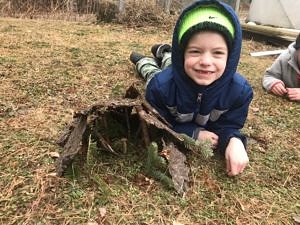
A proud designer sits alongside his peep shelter. (photo © Jenna Spear)
Imaginary World
Make a little person (2-3″ tall) out of a stick. You might find an acorn top to glue on top for a hat.
Build a house for your “peep” out of stuff you find outside. You might make a little mailbox out of bark or a tin can. Now you can send your peep a secret message!
Next, create a trail for your peep to explore.
Engineering
Use sticks, rocks, and other things that you find outside to make a trail going down a hill. Try to include two curves and a jump. Roll a ball down your course. Were you successful? Keep trying until your ball makes it down the hill.
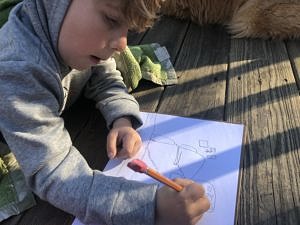
Making a backyard map. (photo © Karen Rent)
Mapmaking
Draw a simple map of your yard. Hide a penny, mark it on your map, and see if someone else can find it.
Hang your map on a wall and keep track of cool nature discoveries.
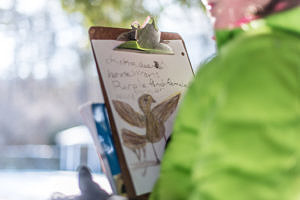
A young naturalist keeps a list of birds she sees at the bird feeder — and picks one to draw. (photo © Ben Conant)
Nature Journaling
Sit outside — or at a window — and draw what you see as spring comes to New Hampshire. Write down questions you have about what you’ve noticed. Which answers can you find out on your own?
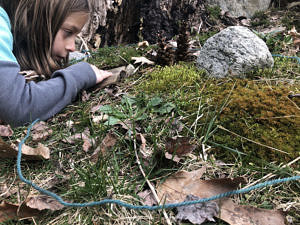
This mini park is called Granite Park. (photo © Karen Rent)
Micro-Parks
Imagine that you are the size of an ant. Tie yarn or string into a loop and use the string to create the border of a very special miniature park.
- What would you name your park?
- What are the park’s special features?
- Where would you put a trail?
ABC Walk
While on a walk, try to find something that starts with each letter of the alphabet. Try to do this in ABC order. You can also challenge yourself to do this inside or in your backyard.
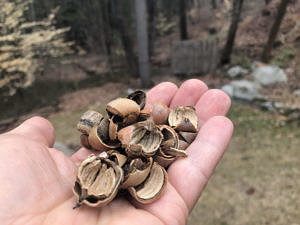
A handful of acorns. Do they all look the same? (photo © Karen Rent)
Acorn Bites
Search around your home for acorn pieces. You might find some that have been nibbled from the top down or others that have been peeled like halves of an orange.
Collect the shells of the acorns that have been eaten and sort them into groups of shells that look alike. Look closely to see if there are any teeth marks on the shell or on any acorn pieces left in the shell.
Which animals do you think might have eaten the acorns and why do you think that?
Scouting Games
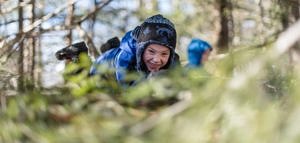
Moving quietly through the forest. (photo © Ben Conant)
A good scout is quiet and stealthy. Practice your scouting skills by trying to sneak up on an animal. See how close you can get to a robin or squirrel. Sit by a bird feeder and see how close the chickadees come. Will a chickadee eat seed from your hand? If you have a dog or cat, you can even try to sneak up on your pet.
Sitting and moving quietly takes practice, but these skills can greatly improve your chances of hearing and seeing wildlife.
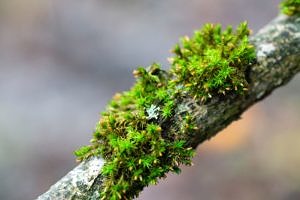
The moss is green. The branch is grey. What other colors can you find? (photo © Markus Spitze via unsplash)
Color Walk
How many colors can you find? You can try to search for a rainbow, or even pick some crayons out of a hat and try to find those colors in nature. You can also try inside each room of your house. This is a great way to test your observation skills.
Rock Collection
Use an empty egg carton to create your own rock collection. Look carefully to find just the right rocks. Try to find rocks that fit into each compartment, and put only one rock in each compartment. For an added challenge, try to find the following:
- a smooth rock
- a striped rock
- a rough bumpy rock
- a spotted rock
- a flat rock
- a rock as small as a grain of sand
- a round (ball-shaped) rock
- a rock that feels good in the palm of your hand
(categories taken from the book Small Wonders: Nature Education for Young Children)
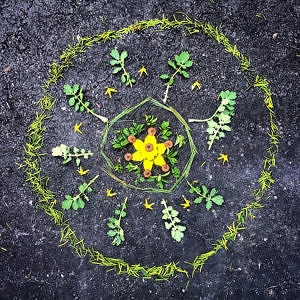
A springtime mandala. (photo © Karen Rent)
Nature Mandalas
A mandala represents the universe in Hindu and Buddhist symbolism. Create your own mandala by gathering natural objects from around your yard or during a walk. Pick a starting point and work your way out from the center. Take some time to notice the textures and smells of the items you are arranging. Use this opportunity to slow down, create a beautiful work of art, and remember that we are also a part of the circle.

Can you describe this natural object without saying its name?
(photo © Aaron Burden via unsplash.)
Descriptive Words
Go into your backyard, sit on your front step, or look out the window. Choose one natural item that you see and write a descriptive paragraph about it without naming it. Be very detailed. Give your description to someone else and see if they can pick out the object that you described.
Shape Walk
Cut different shapes out of paper. Can you find all of these shapes in nature? How many of each can you find? Look for circles, squares, rectangles, diamonds, stars, and any other shapes that come to mind.

A full moon shines through the trees. (photo © Meade Cadot)
Moon Journal
Look out your window or go outside every night and try to find the moon. Draw the moon when you see it or use this template to color the phase of the moon. Does the moon rise at the same time every night? Is it getting bigger or smaller?
One Small Space

A small space filled with big life. (photo © Karen Rent)
Find a spot to get low to the ground. Look closely…really closely. What do you see? Use your nature journal to draw a close up picture of your small square. Do a small space scavenger hunt. Try to find the following things:
- a seed
- an ant
- shredded leaves
- a baby plant
The longer that you look, the more you may discover. Revisit your spot in a week. Has it changed?
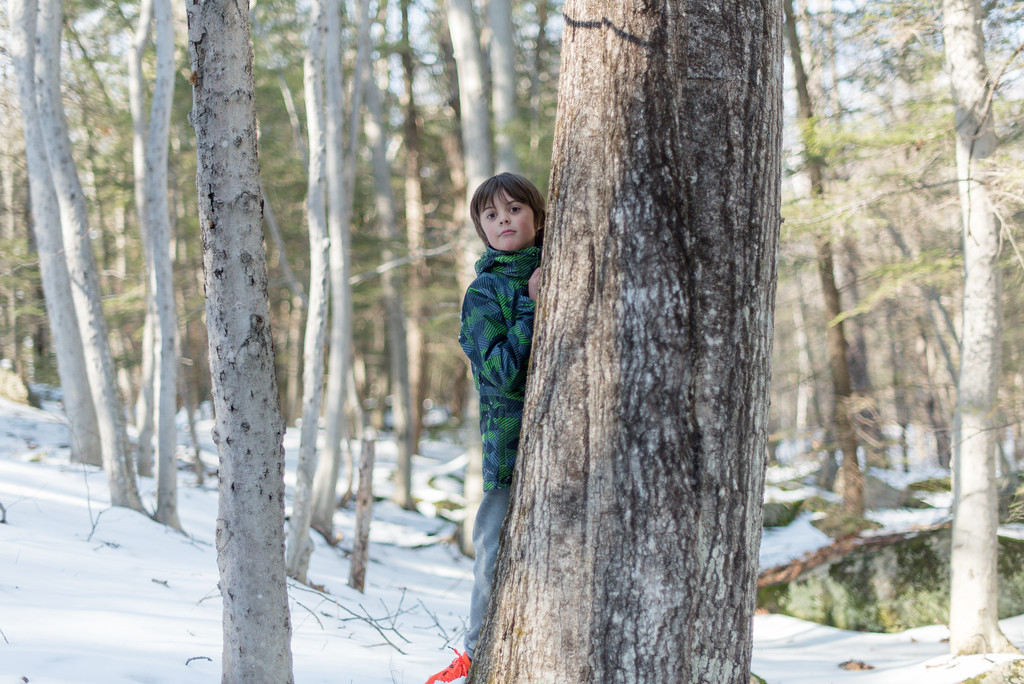
Get to know your tree neighbors. (photo © Ben Conant)
Make Friends with a Tree
Pick out a special tree and watch that tree throughout the year. Draw or write about it in your journal. Here are some things to think about:
- How do the buds change?
- When does it leaf out?
- Do the leaves change color over the season?
- Is the tree growing in the sun or in the shade?
- Does anything eat the leaves?
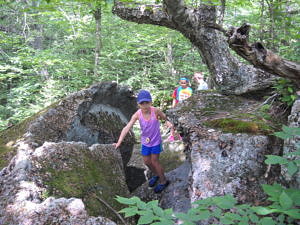
What’s on the other side of these boulders?
Take a Body Radar Walk
There are times when the best plan is no plan at all. Taking a walk without an agenda may uncover some amazing secrets. Learn from our friend, Emily Woodmansee of Among the Ferns, about how to take a body radar walk by watching this video. Then head outside and see where the day takes you. Who knows what you may discover?
Fire Keeper
This game comes from the book Coyote’s Guide To Connecting With Nature by John Young, Ellen Haas, and Evan McGown. It requires at least two people, a blindfold, and an object to steal. It’s a game that will help players move quietly outdoors, a skill that comes in handy when wildlife watching.
The fire keeper is blindfolded and sits cross-legged with an object such as a rock, piece of wood, or something noisy (for extra challenge) placed in front of them. Everyone else stands around the fire keeper in a circle. Those who aren’t blindfolded take turns trying to sneak in and take the object without being heard by the fire keeper. If the fire keeper hears someone, they point to them and the sneaker goes back to their starting point. Play continues until the object is successfully stolen from the fire keeper. Switch places and test out your hearing as well as your sneaking skills!
Nature Poetry
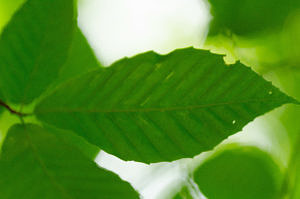
brilliant, green, layered leaves
(photo © Joshua Mayer via Flickr Creative Commons)
Find a quiet spot outside. Take a few moments to use all of your senses and get in touch with the world around you. Let your creative juices flow and capture your moment in a poem. A haiku is a traditional Japanese form of poetry that often focuses on nature or a particular moment in time. Haikus have 3 lines and use the following format:
5 syllables
7 syllables
5 syllables
Here is an example from a recent sit spot:
warm sun and cool breeze
brilliant, green, layered leaves
flowing water sings
Learn more about writing haiku and get inspired to create your own poetry.
Pick Up Sticks
Many different types of stick games have been played by various cultures around the world. Pick up sticks is one of those classic games. The gist of the game is that you want to try to pick up a stick from a pile without moving any of the other sticks. Start by gathering at least 20 sticks and break them into the same size. Follow these directions to play the traditional way or make up your own version of the game.
Nocturnal Explorer

Explore the night.
(photo © Bureau of Land Management via Flickr Creative Commons)
Nocturnal animals have many adaptations that help them navigate the darkness. How do our senses compare? Although it may seem a bit scary at first, exploring in the dark is a great way to experience nature. Most people rarely spend time outside in the darkness, so even familiar places may seem magical and new when explored at night. Pick a familiar trail or turn off the porch lights and head outside into the yard. Do not use a flashlight. Keep in mind that it takes about 20 minutes for human eyes to adjust to the darkness, so give yourself some time to get comfortable. Explore your nocturnal senses by trying out some of these activities:
- Search for colors. Look for various colors in the night. Do certain colors stand out?
- Practice wide-angle vision. The cells in our eyes that see contrast are called rods. Because of the location of rods in our eyes, it works better to use the outside of our eyes when seeing in the dark. Rather than looking directly at a star or faraway object, look to the left or right of it instead. Does it look clearer when you stare at it directly or when you see it from the side?
- Make someone’s head disappear. Sit across from a partner, and stare at their face. After a few seconds, it may seem like their face disappears! This has to do with the location of the rods in your eyes.
- Pause in a sit spot. After exploring for a bit, find a spot to sit quietly for at least 10 minutes. What do you notice?
Bat & Moth
Imagine that you are a bat hunting at night. To play this game, choose one person to be the bat, and help them put a blindfold over their eyes. Every time the bat calls out “bat,” the other players (the moths) call out “moth,” simulating an echo. Just as real bats must rely on echolocation to find food in the dark, the play bat must rely on sound to try and tag one of the moths. Take turns playing the role of bat and have fun!
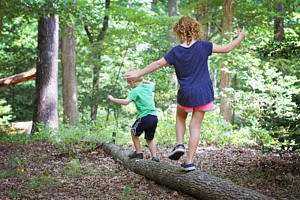
Don’t get swept away by the imaginary flood waters!
(photo © Virginia State Parks via Flickr Creative Commons)
Flash Flood
Playing games during a hike or walk may help during times when folks are feeling tired or ready to turn around. Flash flood has always been a favorite.
Here’s how to play: Someone calls out “flash flood” and counts to ten. In that time, everyone has to get their feet off the ground so they don’t get swept away by the imaginary flood waters. Each person stays on their perch until the caller says the coast is clear. Take turns being the caller — and don’t get wet!
One-In-Three

How would you describe this pine cone to someone?
(photo © bobistraveling via Flickr Creative Commons)
This activity comes from the book Let Nature Be The Teacher by Lucille N. Gertz. Have your partner select three different natural objects and place them in front of you. The best objects are non-living things such as fallen leaves, loose twigs, rocks, and pine cones.
Your partner should select one of these objects, but not tell you which one. Using descriptive words, they should then give you hints until you can correctly guess the one object they’re describing. You can help by asking questions such as, “Is it dried up?” or “Does it have shiny specks?” After you’ve played it once, switch roles (and maybe also objects) and play it again.
Stick Scavenger Hunt
Usually stepped on or kicked aside, the often overlooked stick can provide loads of fun. Make a copy of this stick scavenger hunt and head outside to begin your stick search.
Mystery Bag
Learn about nature using all of your senses. Create a mystery bag as a natural history riddle for your fingertips. Find an empty bag or pouch that you cannot see through. You can use a grocery bag or pillowcase, or make your own pouch using an old shirt. Next, go outside and place a non-living natural object — like a pine cone or acorn or leaf — inside the mystery bag. Have a partner reach into the bag, feel what’s inside, and describe or identify the object. Then, switch roles and give your partner a chance to provide you with a nature mystery.
Squirrel Charades
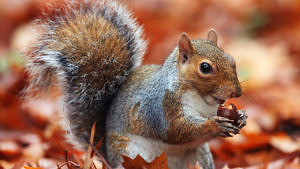
Imagine that you are a squirrel. (photo © PBS Nature)
One of the best ways to learn about an animal is to become that animal. Close your eyes and imagine that your body is sprouting brown fur. Next you grow a bushy tail and your teeth turn orange and become very sharp. You are now a squirrel!
Scurry around outside and look for pretend acorns. Once you find some “acorns,” hide them from other squirrels. Chatter and shake your tail if you see a predator walking nearby. In fact, you may want to take cover until they go away. Make a nest so that you can take a squirrel rest. Go back outside the next day to collect your acorns. Can you find them all?
Nature Museum
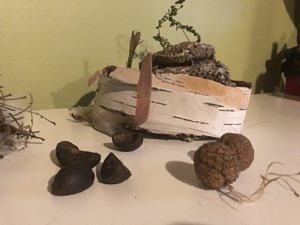
Nature treasures on display. (photo © Karen Rent)
Create your own nature museum filled with treasures you’ve found outside. Find an indoor spot to display your collection. Take the opportunity to look more closely at your treasures and try to learn more about them. If you’re unsure about what something is, try to use a field guide or an online resource to identify it. Teach a family member about the items in your collection.
Does your museum change each season? How many ways can you sort your collection? Do your treasures bring back memories from a special place?
When starting a nature collection, please keep in mind the rules of the area where you’re exploring. Sometimes it’s better to leave an object rather than take it home. These tips from the National Wildlife Federation can help keep your nature museum in check.
Silent Walk
Life can be very noisy. Walking in silence helps calm the mind and may provide the chance to tune into the sounds of nature. Challenge your family to join you for a silent walk, listening in all directions as you go. Do you all hear the same things? If you are unable to take a walk, try to sit quietly in one spot and focus on sounds around you. How long can you be silent? How does it make you feel? Can you hear better in a certain direction?
Wind Watching
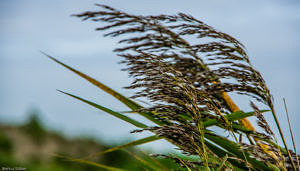
Can you see the wind blowing?
(photo © Markus Stober via the Flickr Creative Commons)
Being aware of the wind can be helpful if you are planning to spend time outside watching wildlife, hiking, boating, or swimming. The Beaufort Scale measures wind speed based on what you can see happening in the world around you. It was originally created in the 1800’s for navy ships and later adapted for other uses. Our teacher-naturalists created this wind scale based on the Beaufort Scale. Go outside or look out the window and see if you can use the wind scale to tell how fast the wind is blowing. Can you see the leaves rustling? Are tree trunks swaying? Keep track of the wind for a week. How has it changed?
Amazing Adaptations
All organisms have adaptations that help them survive in their habitat. Adaptations can be structural (a part of the animal or plant’s body) or behavioral (things that they do). Be a wildlife biologist and see if you can observe an animal and discover its adaptations!
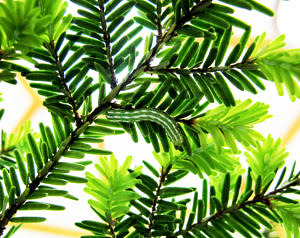
Camouflage is a great example of an adaptation.
(photo © Brett Amy Thelen)
- Gather your materials. First, find a small container (such as a yogurt cup, takeout container, or jar) that you can use to hold a small animal while you observe it. Grab a pencil and some paper, too.
- Find a study organism. Look around your yard or your house for a small animal. Some ideas include worms, pillbugs, ladybugs, centipedes, beetles, or spiders.
- Observe your animal closely. Gently pick up the animal and put it in the container. Take some time to look carefully at it.
- Sketch your animal. What do you notice? What are some of the characteristics that might help your animal to survive? Point out these adaptations in your drawing or use this worksheet to answer questions about your animal.
- Return your animal. When you are done, carefully put your animal back where you found it.
Bark Rubbings

How would you describe the texture of this bark? (photo © Karen Rent)
Learning to recognize bark pattern and texture is an important part of learning to identify trees. Visit an area that has a few different types of trees, and look for tree trunks that have different textures. Can you find a tree with smooth bark, shaggy bark, scaly bark, or peeling bark? What do you notice?
Create bark rubbings to help you remember your trees. Peel the paper off of a crayon, or a few different crayons if you want to get creative. Hold a piece of paper up to the bark of a tree and rub the side of the crayon along the paper until the bark pattern shows through. Make art with your rubbing or turn it into a scavenger hunt by trading your bark rubbing with someone else. Can they find your tree using the bark’s texture as a clue?

The May full moon is also known as the Flower Moon.
(photo © Meade Cadot)
Celebrate the Full Moon
Go for a family full moon walk around the neighborhood or on a familiar trail. How does the landscape look different under the moonlight? What colors can you see? If you can’t get outdoors, enjoy the view from your window. Sketch the moon in your journal or try to look at the moon through binoculars if they are available.
With or without binoculars, the full moon is a beautiful sight!
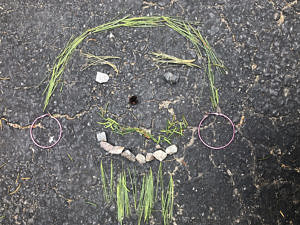
Welcome to the world, Mr. Beardo. (photo © Karen Rent)
Make a New Friend
Gather natural items such as leaves, needles, rocks, sticks, and grass. Use whatever you find to make a face or bring your found objects inside and try to glue or tape them on paper. You’ve made a new friend!
Make a friend during different times of spring and summer. Do they look the same? What kinds of materials did you use? How many colors do you see in your friend’s face?
Cloud Watching

What do you see in the clouds? (photo © Gabriela Parra via Unsplash)
Pick a spot outside or near a window where you can get a good view of the sky. If you are outside, lay on the ground and look up. What do you see? How much of the sky is covered with clouds? What color are the clouds? Can you imagine what it would be like to be a bird flying in the clouds? Do you see any shapes or characters in the clouds? Make up a story and sketch your cloud character.
Getting to know clouds can also help you predict changes in weather. Here is a great resource from NOAA to help you get started.
Rainy Day Adventure
Don’t let the rain keep you indoors! Here are some fun things to do outside on a rainy day:
- Jump over or splash in puddles.
- Make music by putting metal bowls, cans, or other items under the eaves of your house.
- Make a mud pie or stone soup.
- Use a measuring cup to measure the rainfall.
- Notice the rhythm of the raindrops on the trees or roof. Does it change or stay the same?
- Build a dam.
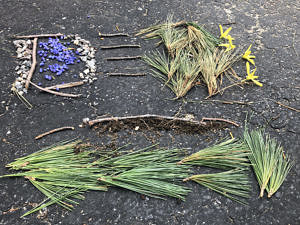
“The pine needles represent my yard!” (photo © Karen Rent)
3D Mapmaking
Map making helps tune up your observation skills and understanding of where you are in relation to the world around you. Instead of simply drawing a map of your yard, make a 3D map using items from outside or inside your house. Use small pebbles to make a rock wall or pine needles to make grass. You could also create a map of your house with blocks, legos, or recyclables. Be creative!
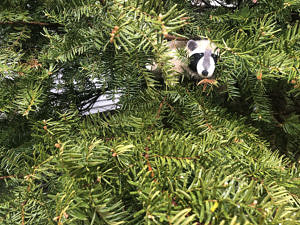
Can you spot the toy raccoon? (photo © Karen Rent)
Stuffed Animal Camouflage
Most animals rely on some sort of camouflage to survive. Blending in with their environment helps predators hunt food and helps prey hide from those that want to eat them. To play stuffed animal camouflage, pick out a few stuffed animals and hide them around your yard or your house. Pick a place where they blend in well with their environment, but don’t forget where you put them! Challenge someone in your family to find them and then trade places. Were some animals easier to find then others? Why?
I Spy Evaporation
Take a walk in the rain or right after the rain stops, and take note of where puddles form. After the rain stops, use chalk to draw an outline around a puddle. Is the puddle still there a few hours later? Did your puddle shrink? If so, you are witnessing evaporation!
If you are unable to go outside, do a similar experiment by filling a cup with water. Place the cup near a window and check it out a few days later. Is the water still at the same level? Learn more about evaporation and the water cycle by visiting NASA’s Climate Kids website.
Kim’s Game

Test your memory with Kim’s game. (photo © Karen Rent)
This classic environmental education game gets its name from Rudyard Kipling’s book Kim. The activity works best with a partner and involves seeing and memorizing natural objects. Collects item from nature such as rocks, pine cones, sticks, and leaves. Place the objects under a blanket or towel. Then, lift the blanket and let your partner look for several seconds with the purpose of memorizing the objects and their locations. Replace the cover, and challenge your partner to find and recreate the hidden objects. If you don’t have a partner, try it yourself. Set up your group of objects, cover them with a blanket, and try to do it again without looking.
Shadow Science
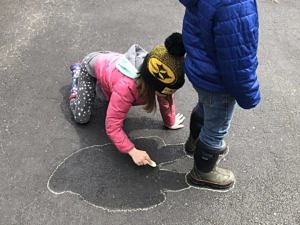
Let’s be shadow scientists! (photo © Karen Rent)
Have some fun with shadows on a sunny day! Play shadow tag with someone or jump on as many shadows as you can during a walk. Use sidewalk chalk and a partner to investigate how shadows change throughout the day. Stand in a spot that will remain sunny for at least a few hours. Have your partner trace your shoes and then trace the outline of your shadow. Come back a bit later and stand in the same spot. Has your shadow moved? How does it look different?
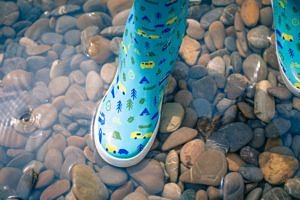
Find a puddle and have some fun! ((photo © Markus Spitze via unsplash)
Sink or Float
Don’t let the rain stop you from exploring! Find a puddle, gather some natural objects, and see which of those items sink or float. What can you use to make a boat? Where do puddles form around your house?
> BACK TO TOP
Spring
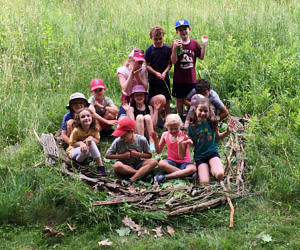
Those are some interesting birds! (photo © Jenna Spear)
Build a Bird Nest
You may notice birds carrying grass and other nesting materials in their beaks right now as they build nests around your neighborhood. Become a bird and build your own bird nest! Make it small like a sparrow or big like a bald eagle. Find inspiration from this online guide to common nesting birds from the Cornell Lab of Ornithology’s NestWatch project. Gather materials, find a nice flat spot to build, and get started. After you build your nest, test its strength by gently blowing on it, placing an egg inside of it, or — if you made a big nest — sitting in it. Does it stay together?
Woolly Bear Hunt
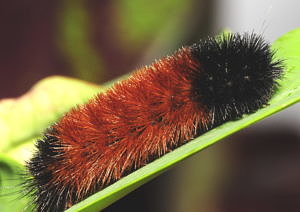
A woolly bear foraging in spring.
(photo © Mike Keating via Flickr Creative Commons)
Woolly bear caterpillars spend the winter curled up in the leaf litter or another sheltered spot. Now they are back on the move, eating green leaves as they prepare for metamorphosis. The insects will emerge from their cocoon in a couple of weeks as Isabella tiger moths. Learn more about these fuzzy animals from Northern Woodlands magazine. If you’re local to the Monadnock Region, you can even adopt one from our friends at The Caterpillar Lab in Marlborough! If you want to find your own, search outside right now before they wrap themselves in their cocoons.
Can you find a woolly bear? Where do you think you should look for one? If you find one, don’t be afraid to pick it up to get a closer look. Just make sure you put it back where you found it. Happy hunting!
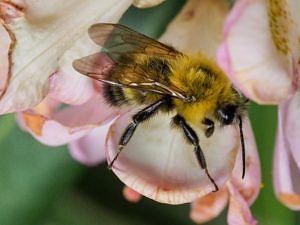
I spy a bumblebee. (photo © Dennis Thompson)
Spy on a Pollinator
A pollinator is an animal that helps move pollen from one plant to another. This helps those plants make fruit or seeds. Now that dandelions and other flowers are blooming, it’s a great time to search for pollinators. Many different insect pollinators visit flowers to drink the nectar, especially bumblebees during springtime.
If you are patient, you may just be able to see an insect in action. Find a flower to spy on. Stay still and be quiet for a few minutes. Did anyone visit your flower?

Have you seen an Eastern Phoebe in your neighborhood?
(photo © Doug Greenberg via Flickr Creative Commons)
Neighborhood Birds
Birds are everywhere! Look and listen for birds in your neighborhood. Can you find evidence of birds and their habitat? Use this scavenger hunt to help guide your exploration. If you don’t have a printer, make your own list and check off what you find.
After you are done exploring, find a spot to sit and listen. The longer that you sit, the more likely that you will hear and see some feathered friends. Try to listen for birds throughout the day. When do you hear the most birds singing?
Project Budburst
Phenology is the study of the timing of biological events, like the migration of birds or when plants flower. Scientists are interested in keeping track of when natural events occur in order to better understand how climate change is affecting plants and animals. You can help out by participating in Project Budburst, a citizen science project of the Chicago Botanic Garden. Our friends at Hubbard Brook Experimental Forest in Woodstock, NH, put together some information on how you can get involved with Project Budburst. Check out their resources and then get started by finding two trees of the same species near your house. Step outside and join folks from around the country by sharing your observations.
Dandelion Life Cycle

A bright spot in a sea of green. (photo © Matt via Flickr Creative Commons)
Dandelions are making an appearance, and they seem to grow everywhere! If you look carefully, you can find the different stages of the dandelion’s life cycle. Watch this time lapse video to get a closer look and then go outside and see if you can find:
- a closed bud
- an open yellow flower
- a closed flower
- a puffball (Make a wish!)
- a puffball that has lost most of its seeds
Try again later in the spring. Can you find more or less?
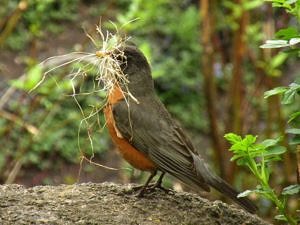
Time to build! (photo © John W. Iwanski via Flickr Creative Commons)
Bird Nesting Materials
This is the time of year when many birds are building nests. Help out your backyard birds by offering gifts of bird nesting materials. Gather dried leaves, birch bark strips, pet fur or cattail fluff and stash it in concentrated spots around your yard. Place items in a mesh bag or suet feeder to hang nearby. You can also leave some on the branch of a nearby tree or in piles around the yard. Learn more from the Cornell Lab about what materials you should provide and which you should avoid. Keep an eye out for nesting birds!

The worm feels smooth. (photo © Ben Conant)
Worm Hunt
Search in the soil for earthworms. How many can you find? Measure them and find the largest and smallest in your area. Can you tell which side is the head?
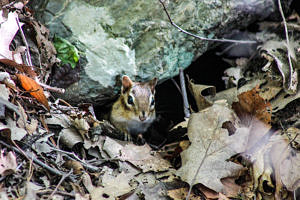
A chipmunk peers out from its hole at the base of a stone wall.
(photo © Monikah Schuschu)
Chipmunk Holes
Now that the snow has melted, search your yard for chipmunk holes. They are about the size of a clementine orange and are found in grass, yards, or often near stone walls. When you find one, look carefully around to see if you can find more. Chipmunks often have several holes, some that are even fake holes. Once you’ve found them, then you can spy on a chipmunk. Can you see it pop up from its hole, scamper down a hole, or sit by its hole and clean its whiskers? Keep a spy log on your neighborhood chipmunk.
Mud Tracking
With all the mud in early spring, now is a perfect time to search for animal tracks. What footprints can you find in and around your yard and neighborhood? Sketch what you see or take a picture with a camera. To help you figure out who’s been in your yard, try using NH Fish and Game’s pocket guide to wildlife tracks.
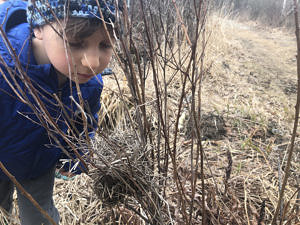
Looking closely at a bird nest. (photo © Karen Rent)
Nest Detective
Since the deciduous trees still lack leaves, now is a great time to search for bird nests! Some birds have begun building nests for this season, but you may also see last season’s nests.
Where is the nest and what is it made of? These questions may help you figure out who built a nest. A field guide or this page from the Cornell Lab of Ornithology can also help with nest detective work.
Early Spring Scavenger Hunt
Head to your nearest trail or conservation land (or even your backyard), and see how many of these you can find! While you’re out there, remember to keep your distance from anyone else you encounter on the trail.

What can you find on your early spring scavenger hunt?
(photo © Ben Conant)
- buds on different kinds of trees
- 5 shades of green
- a new bird sound
- an early spring insect
- a sprout of grass
- a place that could provide shelter for a bird
- mud
- a warm place and a cool place
- something you’ve never seen before
> BACK TO TOP
Summer
Go Batty
If your family takes a walk at dusk, you may notice bats foraging for insects. Bats are the world’s only flying mammals, and although the media often makes them out to be a bit scary, there are many reasons to love bats. New Hampshire has eight species of bats who rely on a variety of habitats throughout the year. Try some of these activities and you just may get an idea of why bats make good neighbors:
- Study neighborhood bats. One of the best ways to learn about an animal is by simply taking the time to observe it. Take a walk at dusk in summer or early autumn, and you might see some bats flying. If you do see a bat or two, spend some time watching them fly. How do they move through the air? How many can you see? If you want to dive deeper, learn about bat habitats with this Neighborhood Bats activity from Bat Conservation International.
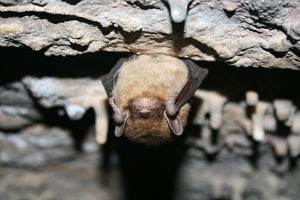
How many mosquitoes can a little brown bat, like this one, eat?
(photo © USFWS / Ann Froschauer) - Bats eat bugs. Scientists have learned that bats can eat up to 1,000 insects in an hour. Turn on your math brain and calculate how many mosquitoes a little brown bat can eat using this Math Challenge worksheet from the Association of Fish and Wildlife Agencies.
- Compare yourself to a bat. Many people call bats flying rodents, but they are not rodents at all. In fact, bats are more closely related to humans than rodents. See how you compare to a bat using this Project Edubat activity.
- Try your hand at echolocation. See the activity “Bat & Moth” below to test your insect hunting skills.
- Build a bat house. Bat houses mimic the tiny crevices in tree bark where many bats find cover or raise their young. The National Wildlife Federation provides instructions on how to build a bat house, so you can make your yard more bat-friendly.
Toad-ally Terrific
Even though toads start out their lives in shallow bodies of water, their adult life is spent on land. Late summer is a great time to search for these critters and, because they are considered habitat generalists, you can find them in many places. Search for toads in forests, open areas, wetlands, parks, and even your own yard. Here are some fun, toad-related activities:
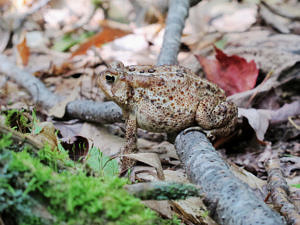
Keep your eyes peeled for terrific toads like this one.
(photo © Brett Amy Thelen)
- Toad Observation. If you find a toad, take some time to look at it closely. How many spots and warts do you see?
- Make a Toad Home. Toads are welcome garden visitors because they eat insect pests. Follow these directions to create a “toad abode” for your garden or yard.
- Toad Olympics. How far you can leap? How many leaps can you make without getting tired? Have a toad race with a friend. Who will win the toad Olympic gold medal?
- Bugs for Me. Play this fun game based on the predator-prey interactions of toads and their insect food. Scroll down on this page for detailed directions from the Association of Zoos and Aquariums.
What’s the Buzz?
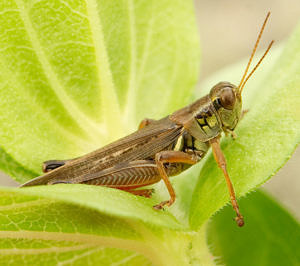
A garden visitor. (photo © Tianne Strombeck)
If you take a walk near a garden or an overgrown, grassy area in late summer, you will likely see and hear many insects. There are many different species of grasshoppers and crickets in New Hampshire, and the best way to tell them apart is through sounds. Crickets create noise by rubbing their wings together, while grasshoppers rub their hind legs against their wings. Grasshoppers also make loud crackling sounds with their wings as they move through the air. Learn more about these animals by reading Sounds of the Season, a Northern Woodlands article by Madeline Bodin.
Challenge yourself to count how many different insect sounds that you notice. Find a busy, buzzy spot and create a sound map of the insects that you hear. (Scroll down for those directions, found in the Sit Spot post.) Try this several times throughout the late summer and fall and see if you notice any changes. Can you get close enough to see an insect make noise?
I Spy a Butterfly
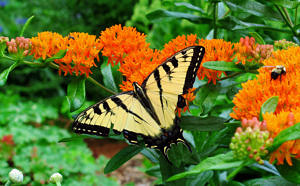
A swallowtail visits the garden. (photo © Brett Amy Thelen)
Summer’s flowers make this season a great time to look for butterflies. Find a spot near a garden, meadow, or overgrown area. Sit quietly for ten minutes and see if you notice any butterflies or other insect pollinators visiting the plants. How many different butterflies do you see? Are they all the same or do you notice different types of insects?
Different plants attract different species of insects. Visit NH PBS’s Wildlife Journal Junior for a list of garden plants that attract particular butterflies in New Hampshire. Learn to identify the species with a field guide or by visiting this butterfly identification website.
Search for Red Efts
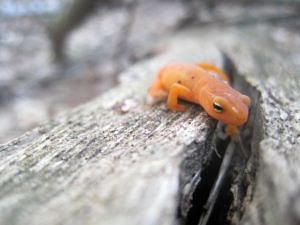
A colorful forest friend. (photo © Brett Amy Thelen)
If you take a walk in a Monadnock Region forest on a damp day, there’s a good chance you’ll see a red eft. These brightly colored amphibians are the juvenile stage of the Eastern spotted newt. They start out as larvae in the water, spend several years on land as red efts, and then return to the water as adults.
If you find an eft, get a closer look and see if you can find its spots. Keep in mind that amphibians have sensitive skin, so it is better to look and not touch. If you do want to hold the animal or move it to a safer spot, get your hands muddy and dirty first, and always avoid touching amphibians if you’ve used bug spray or have lotion or sunscreen on your hands. Learn more about the newt’s life cycle on the NH Fish and Game website.
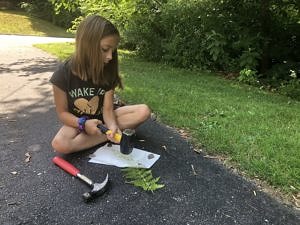
Why not give plant pounding a try this summer? (photo © Karen Rent)
Plant Pounding
Most kids love picking flowers. They also love hitting things with a hammer. This activity combines both of those things. Capture the vibrant colors of summer plants by creating hammered plant artwork. Gather some leaves and flowers and follow these directions from Art in the Garden: Fun Projects for All to get started. You may have to experiment with different types of flowers, but ferns seem to work very well. While you’re gathering plants, can you find a rainbow of colors?
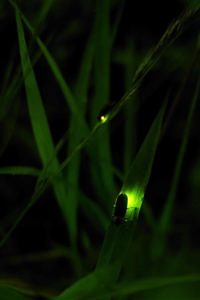
Fireflies light up the summer.
(photo © Takashi Ota via Flickr Creative Commons)
Firefly Watch
Have you seen any fireflies lately? Watching fireflies is a great way to spend a summer night outside. Fireflies are actually a type of beetle, and the flashing light is their way of trying to attract a mate. You can help scientists study fireflies by participating in Mass Audubon’s citizen science project, Firefly Watch. All you need to do is spend 10 minutes a week outside observing fireflies, and share what you’ve seen with the Firefly Watch project. Your observations will help scientists better understand how firefly populations are changing and what factors may be causing those changes.
Firefly Code
Pretend to be a firefly with the help of a flashlight. You and a partner can try to communicate with each other by creating a pattern with flashing lights. Work together to come up with a signal or code, and then stand on separate sides of a play area. Can you speak to each other with your flashing lights?

pressed plant journal (photo © atibens via Flickr Creative Commons)
Pressed Plants
Summer is a perfect time to collect and press flowers and leaves. Pressing plants helps preserve their colors and general outline. Make your own plant press using layers of cardboard and newspaper. This page can show you how.
Once your plants are pressed and dried, they can be used to create many different kinds of art. Use watered down glue or mod podge to glue your pressed plants onto paper. Here are some ideas:
- Make a collage and frame your artwork to hang on the wall.
- Make cards or bookmarks for presents.
- Use clear contact paper to create a suncatcher.
- Use a field guide to identify your plants and create a nature journal.
Roly Poly Investigation

Can you find a roly poly outside?
(photo © Dann Thoms via Flickr Creative Commons)
Take some time to search under leaves or rocks for pillbugs and sowbugs, also known as roly polies. Learn more about these common backyard animals by watching our Wild at Home video.
After you watch the video, go outside and search for pillbugs or sowbugs. Carefully catch one of these critters in a jar and do a close-up observation. Can you see the body segments and count the legs? Draw your animal, including as much detail as you can. If you like, you can use this diagram to label the body parts. Don’t forget to let your friend go after you’ve drawn it.
Insect BioBlitz

Can you find a grasshopper? (photo © Tianne Strombeck)
It is a great time of year to search for insects! Go outside and see how many different insects you can find. Keep track of your discoveries. Try it a few times during the warm season and compare what you have found each time. Use this list to help guide your investigation:
- a beetle
- a butterfly
- an insect with only two wings
- a bee
- an insect that lives in the soil
- a cocoon
- a grasshopper or a cricket
- a caterpillar or grub
- a shiny insect
- an insect that you have never seen before
Take a Nap
Now that school is finished for many of us, it’s a good time to give your body and mind a much needed break. Find a cozy spot in the shade, spread out a blanket, and get some rest. While you’re lying down quietly, you might notice the trees swaying in the breeze or the clouds floating by. Take a few deep breaths, relax, and enjoy some quiet time in nature. You deserve it.
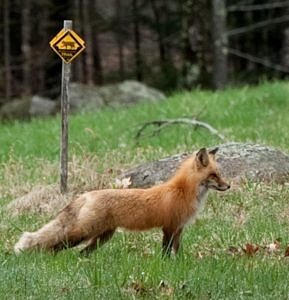
Pretend that you are a fox. (photo © Tianne Strombeck)
Scent Trail
Many animals establish territories by marking them with scents. Mammals may leave droppings, urine, or specially made scents on tree trunks, rocks, and other territorial boundaries to attract mates or to keep competitors away.
Pretend that you are a mammal and set up a scent trail using any strong-smelling scent. Some examples include an onion that you cut in half or scented oil. Go outside and create your trail by rubbing the onion or leaving a few drops of oil every few feet to mark your territory. Then, have a partner try to locate and follow your trail.
Flower Dissection
The purpose of a flower is to attract pollinators — animals that help spread pollen from one plant to another. Let’s say that a hummingbird visits a flower to drink nectar. Pollen from the flower’s anther sticks to the hummingbird’s bill and body. When the hummingbird visits another flower of the same type for more nectar, some pollen from the hummingbird’s body is left on this second flower’s pistil. Pollen then travels down the pistil to the ovary, where seeds will be made. Take a closer look at a flower to see if you can find the parts that make pollination possible. Here’s how:

Take a closer look at a flower. (photo © Ben Conant)
- Go outside and gather a few flowers. Rhododendron, azaleas, and lilies work well.
- Carefully remove the petals. What do you notice about the petals? How do they help attract pollinators?
- Look for the anther, stamen, pistil, and ovary. Use this diagram from Journey North to help. If you can’t find the parts, perhaps you have a composite flower made up of many small flowers. (Dandelions are one example.) Did you get any pollen on your fingers?
- Think about what kind of animal might pollinate your flower. What clues can help you figure out who pollinates your flower? Can flowers spread pollen in other ways?
Create a Coverboard

A red-backed salamander is one animal that you might find under a coverboard. (photo © Tom Murray)
If you are not near a forest, you can place many different kinds of materials on the ground for a couple of weeks, to function as “coverboards” — objects that can provide shelter from light or dryness or cold for many small critters who would otherwise live under logs or rocks. You might use a doormat, a flowerpot, a brick, a piece of wood, cardboard, or newspaper with a rock on top to keep it from blowing away. Leave your coverboard outside and undisturbed for a couple of weeks to give time for small living things like mushrooms, worms, or ants to settle there. Then, follow the same directions as the Rotting Log Investigation (above) to explore who is living under your coverboard.

White pine, hemlock, and cedar paintbrushes create unique pictures.
(photo © Karen Rent)
Natural Paintbrushes
Tie grass, pine needles, or other evergreen leaves around a stick. You can use yarn or a rubber band to keep them tied tight. Then, use the natural paintbrushes to paint a picture.
If you do not have paint, try painting with water on a sidewalk. Do all of the brushes paint the same? How do the textures look different?
> BACK TO TOP
Autumn
Nuts about Squirrels
Did you ever think about why squirrels are able to live in so many places?
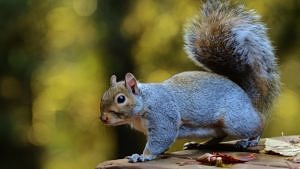
A backyard visitor.
(photo © Jacob McGinnis via the Flickr Creative Commons)
With bodies built to climb, leap, grip, and balance, squirrels can survive in some of the world’s harshest environments. Their adaptability also makes them one of the most easy-to-spot animals in our own neighborhoods. Often overlooked, squirrels provide a great opportunity to become a backyard biologist. Read about New Hampshire’s squirrels by visiting this page from NH PBS, then try some of these activities:
Spy on a squirrel. Watch this amazing National Geographic video of a squirrel escaping a Red-Tailed Hawk. Then go outside and see if you can spy on a squirrel. Find a spot to sit for at least 20 minutes.
Use this worksheet to keep a tally of the behaviors that you observe.
Create a squirrel obstacle course. Create your own backyard squirrel obstacle course using rope, peanuts, pine cone feeders, or other objects that you have around the house. Watch squirrels balance and leap as they try to reach food that you have hanging from the course.
Test out your squirrel brain. Gray squirrels are scatter hoarders, which means that they bury their nuts separately (scattered), rather than all in one place. Researchers are learning that these squirrels are able to use their brains to map out and remember where they hid their acorns throughout the winter. How does your brain compare?
- Round 1: Hide 10 acorns. Wait a week and see if you can find them again. Any luck?
- Round 2: Create a backyard map. Hide 10 acorns and mark them on the map. Go back a week later and see if you can find the acorns. Which round was more successful?
Seed Science
During late summer and autumn, many plants have gone to seed. Plants have developed many strategies to help spread their seeds far and wide. Scientists call this “seed dispersal.” Some plants rely on animals to transport their seeds, while others rely on wind or water. Seed dispersal methods include:
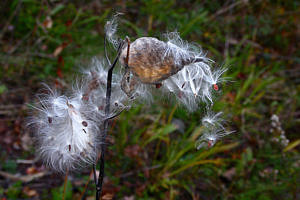
High-flying milkweed seeds are designed to disperse in the wind.
(photo © Liz West via Flickr Creative Commons)
Animal Express. Fruits and berries contain seeds that get eaten by animals and spread to another place when that animal goes to the bathroom.
Hitchhikers. Some seeds have hooks and barbs, similar to velcro, that stick to an animal’s fur or feathers (or your socks.)
Windblown Flyers. Some seeds float through the air, while others twirl like a helicopter. If you have made a wish on a dandelion, you have seen wind dispersal in action.
Water. Many plants that grow near bodies of water or in wetlands have seeds that are designed to float to a new destination. A coconut is type of floating seed.
Now it’s your turn to become a seed scientist!
Gather the materials. For this investigation, you will need a baggie, a tray or paper plates, a cup of water, a piece of fleece or an old sock, and a magnifying glass if one is available.
Collect some seeds. With your parent or guardian’s permission, take a walk outside. Abandoned fields or lots, gardens, and the forest are great places to search for seeds. Put your seeds in a bag to save for your investigation. Make your walk extra interesting by wearing a sock on the outside of your shoe. Do you notice any hitchhikers?
Get a closer look. Spread out your seeds and use the magnifying glass to look closely. What do you notice about the various seed designs? Do you see any barbs? What other shapes do you notice?
Sort the seeds into the various seed dispersal categories. Use the water, sock, and magnifying glass to help figure out where each seed belongs. Throw the seeds up in the air or blow on them to see if they fly or spin. Try to float your seeds in a cup of water. Do you notice any seeds that animals might eat? How many seeds stick to your clothes or the extra sock?
Continue your seed investigation with these ideas:
- Count and create a graph for each seed dispersal type.
- Imagine you are a milkweed seed. Write a story about your journey as you float through the air.
- Design your own seed. Draw your seed or build it out of materials you have laying around your house. What types of seed dispersal methods does your seed use?
Who knew seeds could be so much fun?!
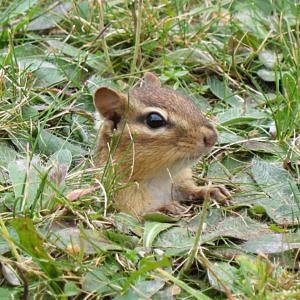
A chipmunk hides in the lawn.
(photo © Giles Gonthier via the Flickr Creative Commons)
Chipmunk Language
Nature has many voices. One of the most vocal backyard voices belongs to the Eastern chipmunk. Chipmunks make a variety of calls: for instance, they “chip” when they’re defending their territory or feel threatened by a land-based predator, and they “chuck” or “cluck” when they notice a hawk or other aerial threat. This National Geographic video highlights the chipmunk’s many sounds.
Sit outside for a bit and listen for chipmunks. If you hear one, look around and try to figure out why it’s calling. Do you notice a predator — or perhaps you are the the reason the chipmunk is sounding the alarm?
Rotting Log Investigation

This rotting log gets the thumbs up! (photo © Jenna Spear)
Rotting logs are a very important part of the forest. Many things live under, inside, and on top of them. Not only do they provide habitat for salamanders, insects, and other creatures, but as they decompose they also become a nursery for new plants to grow. Find a rotting log in the nearby woods and use this tally sheet to keep track of what you find. (If you can’t find a rotting log, see “Create a Coverboard,” below.) Here is how to begin your rotting log exploration:
- Inspect the outside of your log. First, inspect the outside of your log for all kinds of living things such as moss, lichen, fungus, ants, and spiders.
- Gently roll the log. Then, gently roll your log so you can see what is underneath. Use both hands to protect the structure of your log as you roll it. There are likely many small creatures living under and in the log. Carefully look for movement and little animals that live in the dark. There might be holes, like caves, in your log where something lives. Take your time.
- Take a closer look at soil critters. Holding your hand open and close to the log, put a little soil in that hand. Gently lift a critter onto the soil. What do you notice? What do you wonder? Then gently put the critter back where you found it.
- Carefully place the log back where you found it. When you are finished observing your log, gently roll it back in place and replace the leaves or soil you moved so it looks like no one ever turned it over.
> BACK TO TOP
Winter
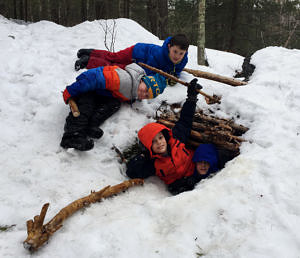
Not quite a quinzhee, but still lots of fun! (photo © Jaime Hutchinson)
Build a Quinzhee
People throughout the world have relied on snow shelters for temporary and more permanent homes throughout time. A quinzhee is a snow shelter that can be made with almost any type of snow (unlike an igloo, which is made of ice). Basically, a quinzhee is made by piling up snow, letting it settle, and then digging out the inside. Once constructed, a quinzhee becomes a great place to find shelter from the cold. In fact, they can be downright balmy! For more detailed instructions on how to make a quinzhee, visit this Girl Scouts website.
Wildlife Tracker

Whose track is that? (photo © Laurel Swope)
Winter’s bare trees and snowy ground make it the best time of year to get an idea of what our animal neighbors are up to. Learning to read animal tracks left in the snow can uncover many stories. Get started by downloading NH Fish and Game’s Pocket Guide to Mammal Tracks. Then, interpret any animal tracks you find using the PAWS technique:
- P – What pattern do you notice? Animals move a certain way based on their body shape. Noticing a track pattern can help you narrow down your possibilities. Track patterns can be found on the side of the pocket guide.
- A – What animals fall into that particular track pattern? Narrow down your possibilities.
- W – Where are the tracks? Paying attention to habitat and location can also help you figure out whose tracks you’re seeing. Do your tracks end at a tree? Are they near the water?
- S – What is the story? Do you see any other clues?
Animal tracking is a skill that takes years to master. Luckily, learning this skill is loads of fun!
Subnivean Zone
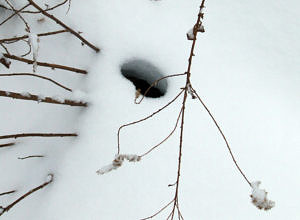
Welcome to the subnivean zone.
(photo © Dave Bonta via the Flickr Creative Commons)
The subnivean zone — defined as the area between the ground and the snowpack — provides a safe haven for many small animals throughout the winter. Not only are these animals better protected from predators, but they also remain sheltered from the cold.
Learn more about life under the snow by reading this Northern Woodlands article, then head outside to look for holes in the snow made by animals living under the snow. Measuring the holes may help you figure out who made them. Make a map showing where the holes are. Go back after another snowfall to see if there are more holes in that area and who made them.
Winter Insulation
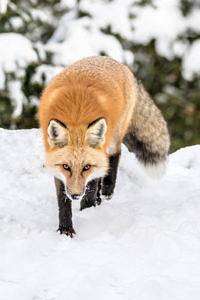
A fox wears a warm winter coat. (photo © Patricia Bauchman via the Flickr Creative Commons)
Think about how you dress before you go outside in winter. Layers of clothing and lots of movement help keep our bodies warm during winter’s coldest days, but how do animals stay warm in the winter? Beavers rely on their thick fur coats. Bears depend on their body fat. Others must find a sheltered place to stay warm — like rodents, who live underneath the insulating snowpack. During this experiment, you will try to either find or create an insulated spot outside of your home. Here are the steps:
- Fill two small containers with hot water. Make sure they have lids and are similar in size.
- If you have a thermometer, record the water temperature in each container.
- Take both containers outside.
- Leave one container out in the open. Then, use natural materials to create an insulated “home” for the other container. Alternatively, you can search for an existing insulated spot and place the second container in it.
- After 20 minutes outside in the cold, retrieve your containers and take the water temperature again in each one.
What do you notice? How much did the temperature change in each container? Was your insulation successful?
Ice & Snow Scavenger Hunt
Did you know there are different types of snow? Snow conditions change depending on the conditions in the atmosphere — and once snow reaches the ground, it changes again. Learn about the different types of snow from the National Snow and Ice Data Center, then head outside for an ice and snow scavenger hunt. Conditions change everyday. What do you notice?
Contact Us
For more information, please contact teacher-naturalist Karen Rent by email.

